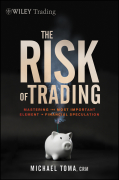
The risk of trading: mastering the most important element in financial speculation
Toma, M.
Develop the skills to manage risk in the high-stakes world of financial speculationThe Risk of Trading is a practical resource that takes an in-depth look at one of the most challenging factors of trading—risk management. The book puts a magnifying glass on the issue of risk, something that every trader needs to understand in order to be successful.Most traders look at risk in terms of a "stop-loss" that enables them to exit a losing trade quickly. In The Risk of Trading, Michael Toma explains that risk is ever-present in every aspect of trading and advocates that traders adopt a more comprehensive view of risk that encompasses the strategic trading plan, account size, drawdowns, maximum possible losses, psychological capital, and crisis management.Shows how to conduct a detailed statistical analysis of an individual's trading methodology through back-testing and real-time results so as to identify when the methodology may be breaking down in actual tradingReveals why traders should think of themselves as project managers who are strategically managing riskThe book is based on the author's unique 'focus on the risk' approach to trading using data-driven risk statistical analytics Using this book as a guide, traders can operate more as business managers and learn how to avoid market-busting losses while achieving consistently good results. INDICE: PrefaceAcknowledgmentsPart I: Principles of Risk ManagementChapter1: Foundations of Risk ManagementA Brief History of the LegislationDefining Risk and Risk ManagementClasses of RiskSummaryChapter 2: Five Steps in the RiskManagement ProcessOverviewStep One: Risk IdentificationStep Two: Risk AssessmentStep Three: Risk ControlStep Four: Measuring RiskStep Five: Monitoring YourRisk ProgramSummaryPart II: Managing and Measuring RiskChapter 3: Predictive Analytics Using Quantitative AnalysisWhat is Quantitative Analysis?The Data-Driven Risk ManagerChapter 4: Statistical Edge and Its Impact on RiskFinding EdgeReducing Variability in Empirical ProbabilityCriteria for Determining EdgeObtaining a Valid Sample SizeProbable Edge vs. Possible EdgeChallenges with Confirmation BiasIndicators that Detect EdgeLeveraging Edge Using ConfluenceSummaryChapter 5: Embracing a Culture of AnalyticsRisk Management Rules for the TraderThe Data Collection ProcessData AssessmentBasic Principles of Measuring DataPerformance Management: What Is the Data Telling Me?Developing a Trade JournalMeasuring Success through a KPITrade Review and Reporting EthicsBenchmarkingPart III: Qualitative Elements of RiskChapter 6: The Human Element: PsychologicalRisks of TradingLoss AversionThe Risk of RegretIntuition TradingThe Success Formula and DisciplineRisk AcceptanceMastering Increases in Share SizeThe Graduation PlanSummaryChapter 7: Preparing for Risk and LossMastering Risk during aTradeThe Need for Plan ComplianceRisk Participation and Loss AcceptanceProcess of Pre-defining RiskTrader ExpectationsBuilding Your Risk TolerancePossible Loss vs. Probable LossKnowing Your Risk AppetiteSummaryChapter 8: Business Risk Management for TradersThe Five Steps of Crisis ManagementScenario Planning and TestingRestoration RequirementsBusiness Impact AnalysisVendor RisksPartnership RisksSupport RisksPersonal RisksCreating a Development PlanSummaryBibliographyAbout the AuthorIndex
- ISBN: 978-1-118-10083-7
- Editorial: John Wiley & Sons
- Encuadernacion: Cartoné
- Páginas: 224
- Fecha Publicación: 02/05/2012
- Nº Volúmenes: 1
- Idioma: Inglés
